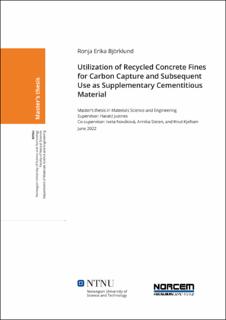| dc.contributor.advisor | Justnes, Harald | |
| dc.contributor.advisor | Nováková, Iveta | |
| dc.contributor.advisor | Steien, Annika | |
| dc.contributor.advisor | Kjellsen, Knut | |
| dc.contributor.author | Björklund, Ronja Erika | |
| dc.date.accessioned | 2022-10-19T17:19:40Z | |
| dc.date.available | 2022-10-19T17:19:40Z | |
| dc.date.issued | 2022 | |
| dc.identifier | no.ntnu:inspera:108217718:37616208 | |
| dc.identifier.uri | https://hdl.handle.net/11250/3027177 | |
| dc.description.abstract | Betong är det vanligaste byggmaterialet i världen, men cementproduktionen står för 5-7 % av det totala CO2-utsläppet. [26] För att minska mängden CO2 från tillverkningen blandas ofta cement med mineraliskt tillsatsmaterial som flygaska. Tillgängligheten på flygaska i framtiden är dock osäker eftersom kolkraftverk ersätts med förnybar energi. [27][31] Samtidigt genereras betongavfall från flera olika branscher inom byggindustrin, som fabriker för betongblandning och prefabelement, och vid rivning av konstruktioner mm. I den här studien undersöks potentialen av att återanvända betongavfall som tillsatsmaterial i cement. Potentialen för att karbonatisera betongavfallet och binda upp CO2 blir också undersökt. Cementblandningar med 80 vt% Industrisement och 20 vt% återvunnet betongpulver styrketestades enligt NS-EN 196-1. Cementblandningarna uppnådde högre styrka än kraven för hållfasthetsklasserna 32,5 R och 42,5 R efter 28 dagar. Både cement inblandad med 20 vt% karbonateiserat eller ej karbonatiserat betongpulver testades. Resultaten visade dock ingen tydlig skillnad i styrka mellan cementblandningarna innehållande karbonateiserat och ej karbonatiserat betongpulver. Termogravimetrisk analys av de karbonatiserade betongmaterialen visade en förmåga att binda upp 0.1 g CO2/g betongpulver. Vilket betyder att 10 % av den ursprungliga CO2 från cementtillverkningen potentiellt kan fångas in och lagras i materialet. Flera av de blandade cementen översteg 80 % i relativ tryckhållfasthet till referensprovet. Vilket indikerar på att det inblandade betongpulvret också bidrar till styrkan, inte bara klinkern. Isotermisk kalorimetri visade lägre kumulativ värme J/g pulver, för cementen innehållande betongpulver jämfört med referensen. Cementblandningarna visade dock högre värme än referensen när värmeutvecklingen justerades till J/g cement, vilket pekar på att betongpulvret bidrar i värmeutvecklingen. Resultaten visade på att ökat CaO/SiO2 - förhållande, ökat CaO3 innehåll, och minskad partikelstorlek gav ökad styrka. Studien visar att det finns potential för att använda karbonatiserat betongpulver inblandat i cement. Framtida studier borde vidare undersöka styrka och beständighet av cement med inblandat betongpulver, effektiv karbonatiseringsmetod i stor skala, och tillgängligheten av dugligt betongavfall. | |
| dc.description.abstract | Concrete is the most common construction material in the world, but the cement production stands for 5-7 % of the total global CO2 emissions. [26] To decrease the amount CO2 generated from the production, supplementary materials as Fly Ash (FA) are frequently used in composite cements. However, the availability of FA in the future is uncertain as coal power plants are replaced by renewable energy. [27][31] At the same time, concrete waste is generated in several steps within the construction industry. At ready mix plants, precast element plants, demolition of constructions etc. In this study, the potential of reusing concrete waste as supplementary material in composite cements is investigated. The potential for carbonating the concrete fines and capturing CO2 is also examined. Composite cement containing 20 wt% recycled concrete fines and 80 wt% Industrisement, was strength tested according to NS-EN 196-1. The composite cements exceeded the requirements for strength class 32,5 R and 42,5 R after 28 days. Both composite cements containing 20 wt% carbonated or non-carbonated were tested. However, the strength test did not show any clear difference between cements containing carbonated or non-carbonated material. Thermogravimetric Analysis (TGA) of the carbonated material showed potential for capturing 0.1 g CO2/g recycled concrete fines. Which means that 10 % of the originally emitted CO2 due to the clinker production potentially can be captured and stored in the material. The compressive strength divided by the reference, showed several composite cements exceeding 80 %. Which indicates that the concrete fines contribute with strength, not only the clinker phases. Isothermal calorimetry showed less cumulative heat J/g powder for the composite cements compared with the reference. However, the composite cements showed higher heat than the reference when adjusted to J/g cement, which indicate that the concrete fines contribute to the heat development. The results showed that higher CaO/SiO2 - ratio, higher content Calcium Carbonate (CC), and smaller particle size gave higher compressive strength. The study shows potential for using carbonated recycled concrete fines in composite cement. Future studies should further investigate the strength and durability of the composite cements, effective carbonation method at scale, and the availability of qualified concrete waste. | |
| dc.language | eng | |
| dc.publisher | NTNU | |
| dc.title | Utilization of Recycled Concrete Fines for Carbon Capture and Subsequent Use as Supplementary Cementitious Material | |
| dc.type | Master thesis | |
